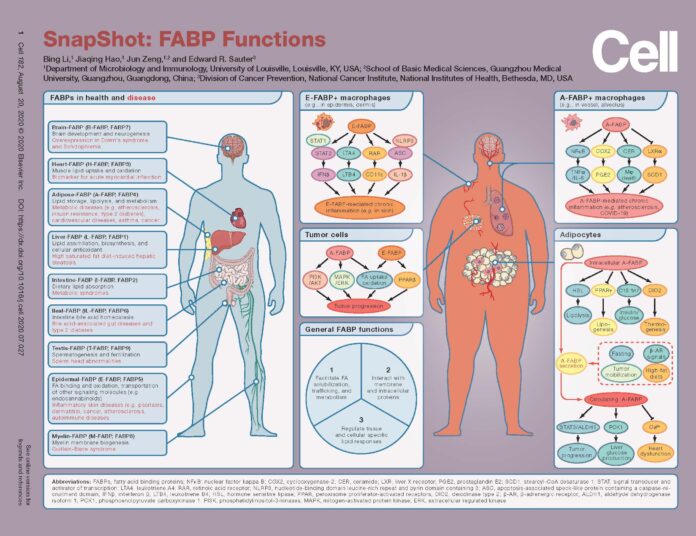
Fatty acid binding proteins (FABPs) serve as a type of chaperone, coordinating the transport of fatty acids and other molecules between cells. Bing Li, associate professor in the Department of Microbiology and Immunology at the University of Louisville and a leading researcher in understanding the role of FABPs, has created a “SnapShot” of the functions of these proteins published in the journal Cell, a highly regarded scientific journal covering cell biology.
At least nine types of FABPs, identified by the tissues and organs in which they were first discovered, are known to have numerous roles in lipid metabolism. While they are responsible for important functions in maintaining health, obesity can result in higher levels of these proteins, igniting disease.
“When people are obese, FABPs in different cells and tissues are upregulated, resulting in changes in lipid metabolism and responses,” Li said.
Li’s research focuses the role of FABPs in chronic inflammation, obesity and cancer development. He recently published a proposed mechanism for how increased levels of one of these proteins, FABP4, resulting from higher amounts of fat tissue, promote breast tumor growth.

“Studies from my laboratory demonstrate that FABP family members, especially FABP4 and FABP5, are critical in mediating obesity-associated diseases by regulating immune cell functions,” Li said. “Thus, our studies on FABPs not only uncover the underlying mechanisms by which obesity undermines human health, but also provide new targets for novel immunotherapeutic strategies for clinics.”
Editors of the journal Cell invited Li to create the SnapShot to illustrate the functions of all known FABPs in health and disease with an emphasis on their role in obesity, chronic inflammatory disease and cancer. SnapShots are graphic diagrams designed to serve as quick reference guides for researchers on a specific topic.
“The SnapShot format offers a great deal of opportunity for creativity and can be printed and pinned above lab benches to jog researchers’ memories,” Li said. “While our studies open a window to see the important functions of FABP family members in some disease contexts, a lot of questions remain unexplored in this field. I hope this piece will encourage more young scientists to contribute their talents to combat obesity and obesity-associated diseases.”































